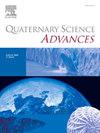Late Quaternary thrust faulting along the NW-trending Heya fault in southwestern Tian Shan, NW China
IF 2.2
Q2 GEOGRAPHY, PHYSICAL
引用次数: 0
Abstract
Along both the northern and southern flanks of the Tian Shan orogenic belt, a series of foreland thrust systems have been developed to accommodate N – S crustal shortening. The strikes of these foreland thrust systems are roughly parallel to the mountain range and have usually been viewed as a result of outward expansion of the Tian Shan orogenic belt. However, the NW-striking Heya fault (HYF) in the southern Tian Shan piedmont has been identified, but at present, its late Quaternary kinematics, deformation mechanism and role in regional tectonic deformation are still unclear. In this study, based on interpretations of detailed high-resolution remote sensing images, field investigations, surveys of displaced terraces with an unmanned drone, dating of late Quaternary sediments via optically stimulated luminescence (OSL) and trench excavation, we quantified the structural geometry and determined the ∼0.85 mm/yr crustal shortening rate of the HYF. A survey of the displaced geomorphic surfaces implies that the HYF obeys a characteristic slip model. We suggest that the low-angle thrust HYF is a contractional horsetail structure located near the easternmost end of the Maidan fault and accommodates its left-lateral strike-slip motion.
天山西南部晚第四纪逆冲断裂北西走向的鹤牙断裂
天山造山带南北两侧发育一系列前陆逆冲体系,以适应南北地壳缩短。这些前陆逆冲体系的走向大致与山脉平行,通常被认为是天山造山带向外扩张的结果。虽然在天山山前南段已发现北西向的鹤牙断裂,但目前对其晚第四纪运动、变形机制及其在区域构造变形中的作用尚不清楚。在这项研究中,基于详细的高分辨率遥感图像解释、野外调查、无人驾驶飞机对移位梯田的调查、通过光学激发发光(OSL)和沟槽挖掘对晚第四纪沉积物进行测年,我们量化了HYF的结构几何形状,并确定了约0.85 mm/yr的地壳缩短速率。对位移地貌表面的调查表明,HYF服从一个特征滑动模型。低角度逆冲HYF为收缩马尾构造,位于迈丹断裂最东端附近,适应其左旋走滑运动。
本文章由计算机程序翻译,如有差异,请以英文原文为准。
求助全文
约1分钟内获得全文
求助全文
来源期刊

Quaternary Science Advances
Earth and Planetary Sciences-Earth-Surface Processes
CiteScore
4.00
自引率
13.30%
发文量
16
审稿时长
61 days
 求助内容:
求助内容: 应助结果提醒方式:
应助结果提醒方式:


